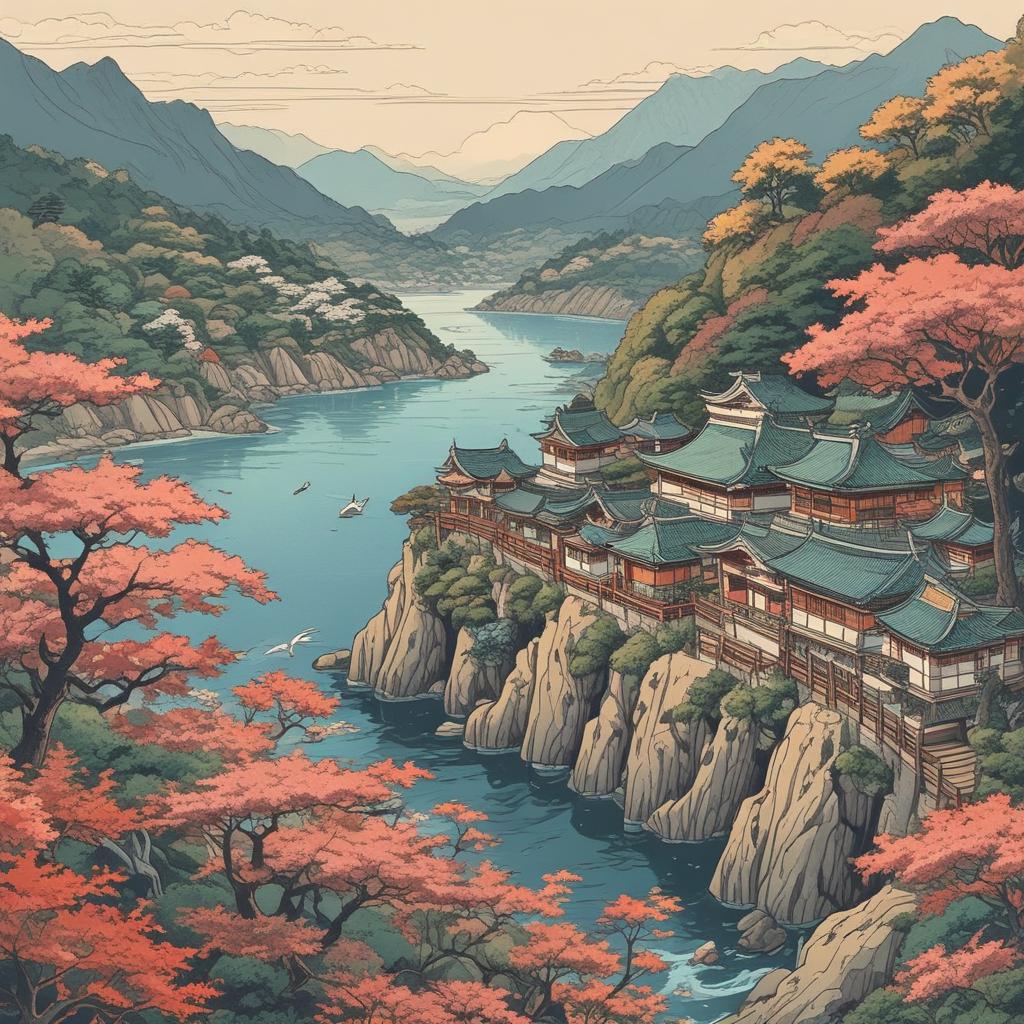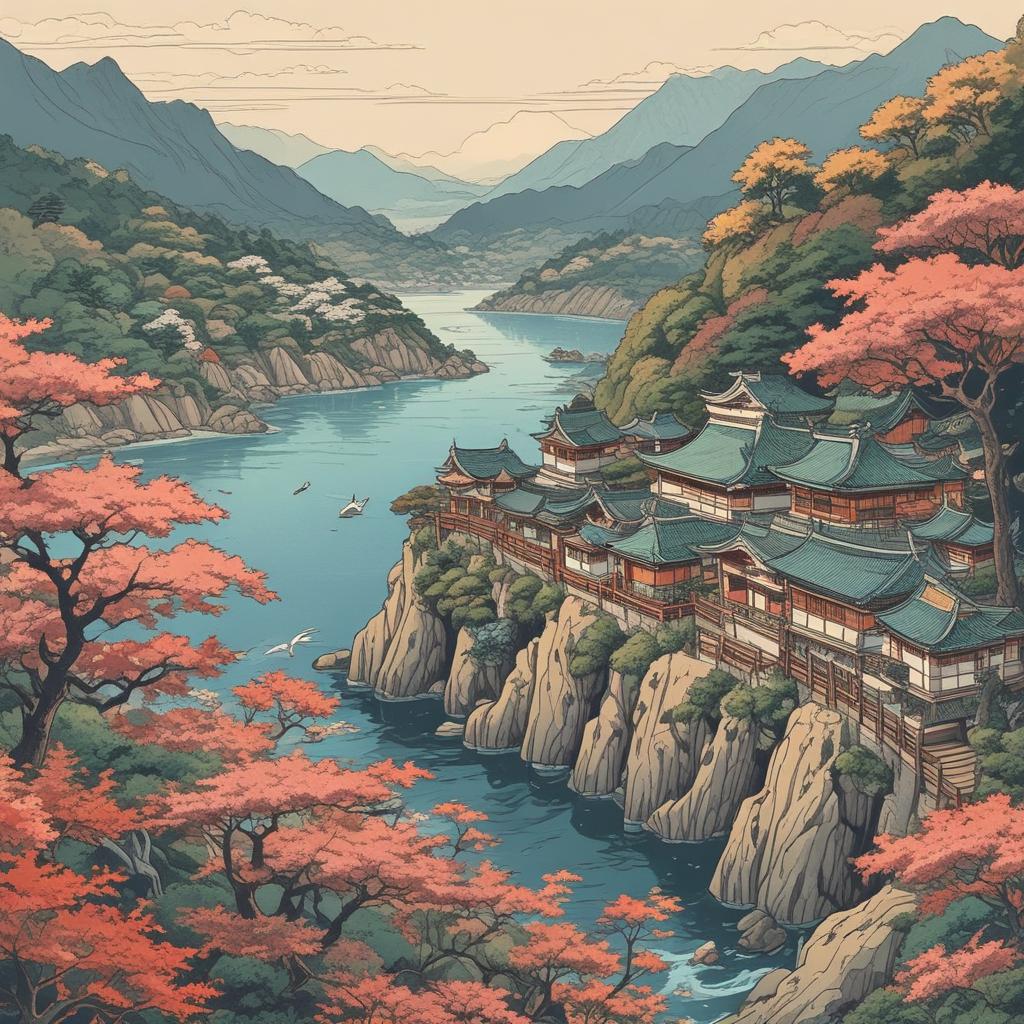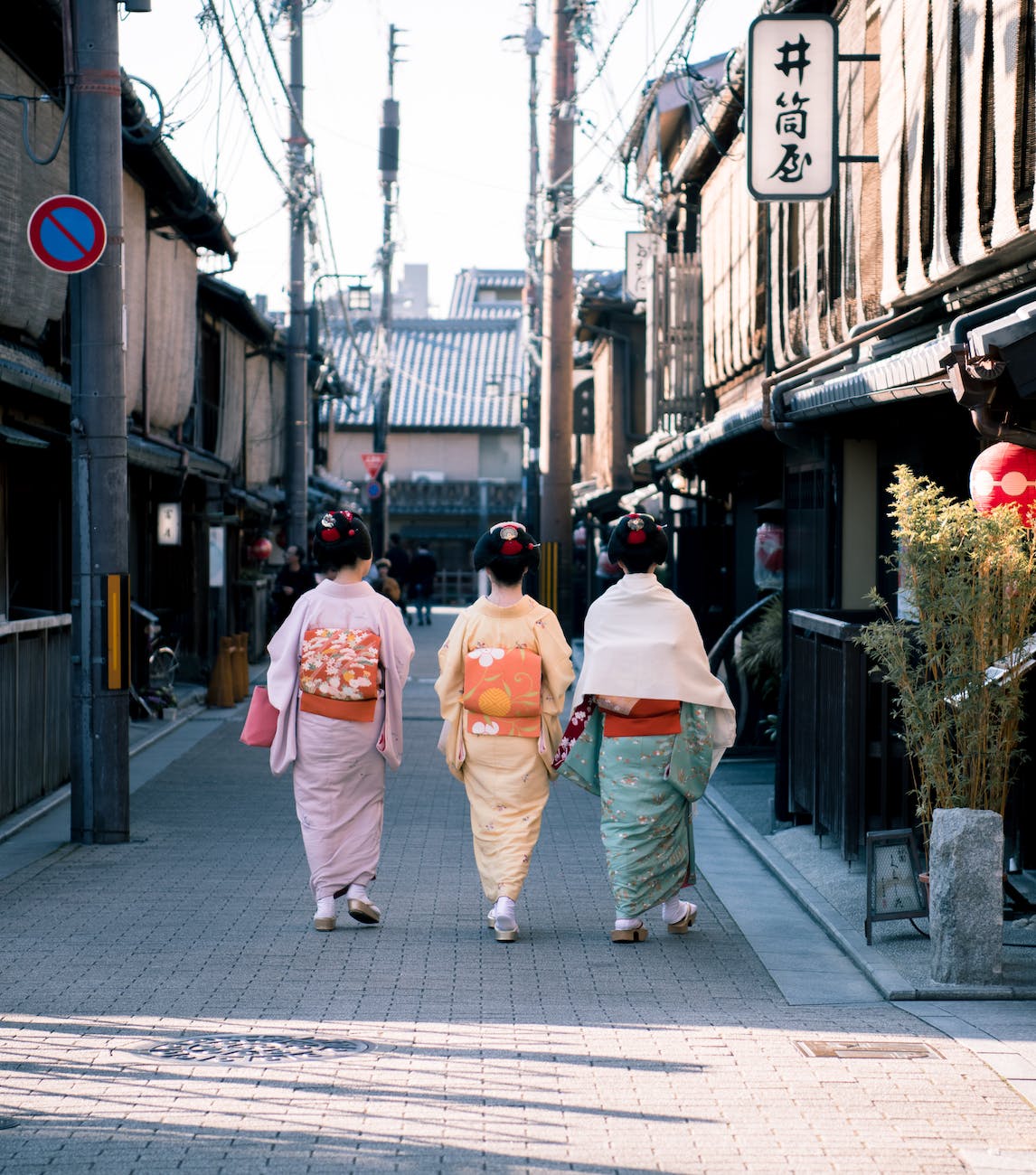Hello to all history enthusiasts! Today, we’ll shine a spotlight on Shikoku, a region deeply entrenched in the ancient history of Japan, particularly focusing on the areas historically known as Awa (now Tokushima Prefecture) and Iyo (now Ehime Prefecture). Shikoku isn’t just another travel destination; it’s a place where deep history, culture, and mystique intertwine. Through this article, I hope to share the allure of Shikoku with many more people.
Historical Background of Awa
Awa faces the Seto Inland Sea and has thrived since ancient times as a key maritime hub. The region is dotted with remains from the Yayoi period, narrating tales of ancient lives and interactions. Particularly noteworthy is the Kofun period, marked by the construction of large burial mounds, signifying its role as a political center. Alongside its rich natural scenery connected to the sea, Awa offers a glimpse into the politics and culture of ancient times.
The Charms of Iyo
On the other hand, Iyo is home to the mystical Mount Ishizuchi, a significant site for ancient religious rituals, highlighting the area’s importance since ancient times. Iyo was a hub for ancient iron production, thanks to its rich iron resources, playing a crucial role in the economic activities of the period. The region is also part of the Shikoku Pilgrimage route, revered since ancient times as a path of faith, cherished by many.
Shikoku Pilgrimage – A Spiritual Culture from the Past
Shikoku is famously known as the “land of pilgrimage.” Traveling through the eighty-eight sacred sites of Shikoku is an ancient form of religious journey, bustling with people seeking spiritual cleansing and new beginnings. Understanding how this religious backdrop has influenced the region’s culture and society can deepen one’s interest in Shikoku’s profound history.
Conclusion
As such, Shikoku is not just any region; it is a valuable place where Japan’s history, especially ancient history, is vividly preserved. Visiting Awa and Iyo allows one to experience the integration of local history, culture, and nature. Shikoku is a must-visit for history buffs or travelers seeking new discoveries. Stepping out from the pages of history and visiting these lands personally can lead to new insights and emotional encounters. I hope this article resonates with many, spreading far and wide through shares. I look forward to your comments and shares as we explore Shikoku together!
カテゴリー: Ancient Japan
四国地方の魅力を再発見!―古代日本の歴史が息づく「阿波の国」と「伊予の国」
こんにちは、歴史探訪が趣味の皆さん!今回は、日本の四国地方にスポットを当てて、古代の歴史が色濃く残る「阿波の国」と「伊予の国」の魅力に迫りたいと思います。四国はただの旅行先ではなく、深い歴史と文化、そして神秘が交錯する地です。この記事を通じて、そんな四国の魅力を多くの人に知ってもらえたら嬉しいです。
阿波の国の歴史的背景
阿波の国(現在の徳島県)は、瀬戸内海に面し、古代から海上交通の要所として栄えました。この地域には弥生時代の遺跡が点在し、古代の人々の生活や交流の様子を今に伝えています。特に注目すべきは、大きな古墳が造られた古墳時代。政治の中心地としても重要な役割を果たしていたことがうかがえます。海とつながる豊かな自然と共に、古代の政治や文化の息吹を感じることができるのが阿波の国の魅力です。
伊予の国の魅力
一方、伊予の国(現在の愛媛県)には、神秘的な石鎚山がそびえ立ちます。石鎚山は古代宗教の儀式の場としても重要で、この地域が古代から特別な意味を持っていたことを示しています。伊予は鉄資源が豊富で、古代の鉄器生産の中心地として栄え、経済活動の一翼を担っていました。また、四国八十八箇所の遍路道がこの地を通ることもあり、古代から続く信仰の道として、多くの人々に親しまれています。
四国遍路―古代から続く精神文化
四国は「遍路の地」としても知られています。四国八十八箇所を巡る遍路は、古代から続く宗教的な旅であり、精神的な浄化や新たな始まりを求める人々でいつも賑わいます。この宗教的な背景が、地域の文化や社会にどれほど影響を与えているかを理解すると、四国の深い歴史に更に興味を持つかもしれません。
まとめ
このように、四国地方はただの地方ではなく、日本の歴史、特に古代の歴史を今に伝える貴重な場所です。阿波の国と伊予の国を訪れることで、その地の歴史や文化、自然と一体となった感覚を体験することができるでしょう。歴史好きな方、または新たな発見を求める旅行者にとって、四国は必見の地です。
ぜひこの記事が皆さんの興味を引き、四国地方のさらなる探訪へとつながれば幸いです。歴史のページから一歩出て、直接その土地を訪れてみることで、新たな発見や感動があるはずです。そして、この記事が少しでも多くの方々に共感され、広くシェアされることを願っています。皆さんのコメントやシェアをお待ちしております!
Learning Deep Lessons from the Demon’s Castle in the Legend of Momotaro
Have you ever heard of the story of “Momotaro”? It’s a famous Japanese folk tale where the hero, Momotaro, along with his companions, battles demons to bring peace to the land. But why do the demons depicted in the story, especially the lord of the Demon’s Castle, Ura, gain popularity despite being villains?
This phenomenon goes beyond the mere charm of the story, holding the key to understanding the depth of Japanese culture. Japanese culture doesn’t rely on a simple dichotomy of good and evil but values the complexity and multifaceted nature of things. The deep affection and fascination for characters like Ura and other demons, despite their villainous roles, stem from this cultural backdrop.
The Complexity of Villains
One reason for the popularity of demon characters like Ura is the fact that they are not just mere villains. In Japanese stories, demons and villains often come with their own stories, backgrounds, and struggles. There’s an attempt to understand why they act the way they do and what they feel, making them characters with whom people can empathize, portraying them as more human and relatable.
The Appeal of Strength and Rebellion
Moreover, the strength and spirit of rebellion that characters like the demons possess appeal to many. These characters are sometimes seen as symbols of resistance against oppression and injustice or as embodiments of courage to face difficulties with self-belief. This empathy towards such characters resonates especially in modern society, which values self-actualization and independence.
Demons in Subculture
In the realm of Japanese subculture, demons and villainous characters often develop their own fan bases. These characters, with their unique designs and distinctive stories, stimulate the imagination of fans and attract deep interest. Characters like Ura provide fans with new perspectives and opportunities for thought through their complexity and dynamism.
Conclusion
The reason why a villainous character like Ura is beloved lies in their complexity, strength, and the deep cultural roots they represent. These elements make them not just mere antagonists but enrich the stories and culture with their diversity. Our fascination with such characters may stem from their deep humanity, rebellious spirit against society, and the profound messages conveyed through their stories.
I hope this blog post serves as an opportunity to view the legend of Momotaro and its demons from a new perspective. If this article resonates with you, feel free to share it and expand the discussion on this intriguing topic.
Japan’s Mysterious 4th Century: Empathy and Discovery from the Past
In the tapestry of Japan’s history lies a period referred to as the “mysterious 4th century.” This era, spanning the late 3rd to the 4th century, approximately 1700 years ago, is characterized by a scarcity of historical records, shrouded in mystery. Yet, it is this very lack of information that stirs our imagination and fosters a deep empathy towards ancient Japan.
Empathy with Political Diversity
Archaeological findings and Chinese historical texts suggest that during this time, the Japanese archipelago was home to various regional powers. Each of these entities had its unique political system and embraced different cultures and technologies. This political diversity offers a parallel to our contemporary society, where diverse cultures and ideologies coexist. The varied regional powers of yesteryears can be seen as a precursor to modern Japan’s multifaceted society.
Empathy with Social Diversity
With the advancement of agricultural society, differences in the scale and structure of settlements emerged. The beginning of the Kofun period, marked by the appearance of large tomb systems, indicates changes in the societal hierarchy and power structures. These burial mounds varied significantly in shape and size across regions, reflecting the cultural and societal distinctions of each area. Today, we can relate to our roots and the uniqueness of our local communities, deepening our understanding of each other’s backgrounds.
Empathy with Cultural Diversity
During this era, the Japanese archipelago was influenced by external cultures. The influx of new technologies and cultural practices from China and the Korean Peninsula is evident in the artifacts discovered, such as pottery, metalwork, and ornaments. The widespread use of iron tools revolutionized agriculture and warfare, significantly impacting societal development. In contemporary times, we continue to enrich our lives through the adoption of foreign cultures and technologies. This cultural diversity fosters an environment where we can embrace new perspectives and ideas, enhancing our own culture in the process.
Empathy with the Past, Steps Towards the Future
The mysterious 4th century reveals the diverse history and culture of Japan, from past to present, and into the future. Like us, the people of this era interacted with a variety of cultures, adopting and adapting them to enrich their own. This historical journey not only deepens our empathy for the past but also inspires us to consider the possibilities of the future. By embracing diversity, we can continue to grow together, building a richer culture.
Reflecting on this enigmatic era allows us to reconnect with our roots and appreciate the importance of accepting different cultures and values. Though the mysterious 4th century is a tale from the distant past, it resonates closely with us, filled with empathy and discoveries.
The Role of the Present in Preserving the Past: The Significance of Japan’s Ancient Tumuli”
Hello, everyone. Today, I want to discuss a special topic that takes us back through time. We’re going to explore why Japan’s ancient tumuli, or kofun, are not excavated. These mounds are more than just ancient hills of earth. They’re messages from the past, cultural heritages, and gifts from our ancestors.
Respect and Protection: The Bond between Modern Society and Ancient Tumuli
Are you aware of why these tumuli are so special? Built between the 3rd and 7th centuries, they are some of the most mystical relics in Japanese history. However, they are more than just historical sites. They hold significant meaning for many Japanese people today, representing respect for ancestors and deep reverence for history.
Delicate Process: The Technique of Excavating Tumuli
Excavating these tumuli is not just about digging. It’s like a time travel to the past, requiring extremely delicate techniques and profound expertise. A single mistake could mean the loss of invaluable historical information forever. This is why we need to treat these tumuli with care and respect.
Time and Resources: The Reality of Excavation
Did you know that excavating tumuli requires an enormous amount of time and resources? In Japan, decisions must be made carefully about which tumuli to excavate, given the limited budget. This is a crucial decision for connecting our historical heritage to the future.
The Meaning of Cultural Heritage: Tumuli to Us
Finally, tumuli are not just remnants of the past. They are an essential part of our culture, identity, and history. Through these tumuli, we can connect with the lives, beliefs, and dreams of our ancestors.
By preserving and valuing these tumuli, we bridge the past and the present, building a pathway to the future. I hope this blog helps you appreciate the deep historical significance of these ancient tumuli and the modern role in preserving them.
Let’s cherish the message these Japanese tumuli convey to us. It’s our collective responsibility to honor the past and build the future.
Learning from the Jomon Era: The True Meaning of Letting Go of Possessions and Attachments
Introduction: Hello, everyone! Today, I want to talk about an important lesson we can learn from the people of Japan’s Jomon period, especially focusing on how letting go of material possessions and attachments can bring peace and harmony into our daily lives.
Life in the Jomon Era: The people of the Jomon period in Japan lived in harmony with nature. They did not try to dominate nature but lived by adapting to and appreciating its blessings. For them, material possessions were merely necessities for living and not objects of excessive attachment. This offers a significant hint for us modern people.
The Importance of Letting Go of Possessions and Attachments: Our contemporary society constantly pressures us to ‘possess more.’ However, like the people of the Jomon era, letting go of our attachment to material possessions can bring us inner peace. The fewer possessions we have, the less worry and anxiety we will have about them.
Applying to Modern Life: So, how can we incorporate this ancient wisdom into our modern lives? Start by reassessing what you own and keeping only what is truly necessary. Also, prioritize human relationships over material things, and cherish connections with community, family, and friends.
Conclusion: This lesson from the people of the Jomon era can reduce stress and anxiety in modern society, paving the way for a more peaceful and happier life. Letting go of possessions and attachments is not just about discarding material things; it’s about pursuing mental peace and happiness. Try incorporating the teachings of the Jomon period into your daily life for a more fulfilling experience.
Afterword: I hope today’s blog serves as a valuable source of information and brings a fresh perspective to your daily life. Please feel free to share your thoughts and experiences in the comments and through sharing!
縄文時代の教えから学ぶ:所有と執着を手放すことの真の意味
はじめに: 皆さん、こんにちは!今日は縄文時代の日本から、私たち現代人が学べる大切な教訓についてお話ししたいと思います。特に、物質的な所有と執着を手放すことが、どのようにして私たちの日常生活に平和と調和をもたらすかに焦点を当ててみましょう。
縄文時代の生活とは: 縄文時代の日本人は、自然との調和の中で生活していました。彼らは自然を支配しようとせず、自然の恵みに感謝し、それに適応することで暮らしていました。この時代の人々にとって、物質的な所有は生活の必需品に過ぎず、過剰な執着の対象ではありませんでした。これは、私たち現代人にとって重要なヒントを与えてくれます。
所有と執着を手放すことの重要性: 私たちの現代社会は、常に「もっと多くを所有するべきだ」という圧力にさらされています。しかし、縄文時代の人々のように、物質的な所有に対する執着を手放すことで、心の平穏を得ることができるのです。所有物が少なければ、それに対する心配や不安も少なくなります。
現代生活への応用: では、私たちはどのようにしてこの古代の教訓を現代生活に取り入れることができるでしょうか?まずは自分の持ち物を見直し、本当に必要なものだけを選ぶことから始めましょう。また、物質的なものよりも人間関係を重視し、コミュニティや家族、友人とのつながりを大切にすることが重要です。
結論: 縄文時代の人々から学ぶこの教訓は、現代社会におけるストレスや不安を減らし、より平和で幸福な生活への道を開くことでしょう。所有と執着を捨てることは、心の平穏と幸福を追求する過程でもあるのです。みなさんも、縄文時代の教えを日常生活に取り入れて、より充実した生活を送ってみてはいかがでしょうか。
あとがき: 今日のブログが皆さんにとって有益な情報源となり、日々の生活に新たな視点をもたらすことを願っています。コメントやシェアを通じて、皆さんの考えや経験も是非共有してくださいね!
The Allure of the Jomon Civilization: Delving into Japan’s Deep Maritime Roots
Hello, everyone! Today, we’ll be focusing on an enchanting aspect of ancient Japan: the Jomon Civilization. Have you heard of it? Let’s dive deep into its unique pottery, rituals, and maritime culture.
1. What is the Jomon Civilization?
The Jomon Civilization thrived on the Japanese archipelago from approximately 13,000 years ago to about 2,300 years ago. Their lifestyle centered not only on hunting deer and wild boar but also on gathering fish and shellfish. This gives us a glimpse of how extensively the Jomon people utilized their waterfront environment.
2. The Jomon People: A Maritime Society
Living by the sea and rivers, the Jomon people engaged in interactions and trade with different regions. The discovery of minerals and specific shells from far-off areas at Jomon archaeological sites suggests a vast network of exchanges.
3. The Influence of the Jomon Civilization
The Jomon’s distinctiveness and diversity persisted even as they engaged with external cultures, continuously valuing their unique values and traditions. This has influenced the development of Japan’s early history and culture, forming the foundation of the nation’s ethnical identity we recognize today.
4. Conclusion
The Jomon Civilization is crucial for understanding Japan’s maritime identity and its cultural diversity. Feeling the allure of the Jomon and recognizing its influence can deepen our appreciation of Japanese history and culture.
I encourage everyone to explore the Jomon Civilization as a gateway to experience the profound history of Japan!
That’s it for today’s exploration of the Jomon Civilization’s allure. Stay tuned for more intriguing topics on Japan’s history and culture in our upcoming posts!
The Enchanting World of Japanese Classical Literature: A Journey Through Its Diversity and Depth
Introduction
Japanese classical literature is richly diverse, ranging from haiku and senryu to tanka, narratives, and military epics. In this article, we will explore this diversity, its fascinating aspects, and why these literary forms continue to be cherished today.
1. Haiku: Capturing Nature and Human Emotions with Finesse
Haiku is a short poem consisting of 17 syllables, often focused on depicting nature and human emotions. It employs unique techniques such as seasonal words (kigo) and cutting words (kireji) to express deep meanings and emotions.
2. Senryu: From Everyday Life to Social Satire
Senryu also consists of 17 syllables and centers around themes from daily life and social satire. Despite its simplicity, this form offers sharp insights and is cherished by many.
3. Tanka: Versatile Themes and Sophisticated Expression
Tanka is made up of 31 syllables and handles a variety of themes such as emotions, landscapes, and events. Often involving intricate poetic techniques, it is considered one of Japan’s oldest poetic forms.
4. Narrative Literature: The Allure of “The Tale of Genji”
“The Tale of Genji,” written by the female author Murasaki Shikibu, is considered the world’s oldest novel. It intricately portrays the complex relationships and various characters of the aristocratic society of its time.
5. Military Epics: War and the Human Struggle
Military epics focus on wars and warriors, with works like “The Tale of the Heike” and “Taiheiki.” Not only do they depict brave feats of valor, but they also delve into the emotional conflicts and tragedies of war.
Conclusion
Japanese classical literature, with its variety of genres and unique expressive techniques, provides deep insights into human understanding and rich emotional experiences. The enduring love for these works in modern times can be attributed to their universal themes and emotions that resonate across time and culture.
日本の古典文学:多様性と深みの不思議な世界
イントロダクション
日本の古典文学は、俳句から短歌、川柳、物語、軍記物に至るまで多様性に富んでいます。この記事では、その多様性と面白さ、そしてどうしてこれらの文学形式が現代まで愛され続けているのかを探っていきます。
1. 俳句:自然と人々の心情を繊細に描く
俳句は17音から成る短詩で、自然や人々の心情を描き出します。特に季語と切れ字の使い方が独特で、深い意味や感情を表現します。
2. 川柳:日常生活から社会風刺まで
川柳もまた17音で、日常生活や社会風刺をテーマにします。シンプルながらも鋭い洞察力を持つこの形式は、多くの人々に親しまれています。
3. 短歌:多様なテーマと高度な表現
短歌は31音からなり、感情や風景、出来事など多様なテーマを扱います。高度な表現技巧が用いられることもあり、日本最古の詩形の一つです。
4. 物語文学:『源氏物語』の魅力
『源氏物語』は世界最古の長編小説で、女性作家・紫式部によって書かれました。多くの登場人物と複雑な人間関係を通じて、当時の貴族社会が繊細に描かれています。
5. 軍記物:戦争と人々の葛藤
軍記物は戦争や武将に焦点を当てた文学で、『平家物語』『太平記』などがあります。勇敢な武勇伝だけでなく、人々の心の葛藤や戦争の悲劇も詳細に描かれています。
コンクルージョン
日本の古典文学は、多様なジャンルと独自の表現手法で、深い人間理解と豊かな情緒を持っています。これらの作品は現代でも多くの人々に愛され続けているのは、普遍的なテーマと感動が時代や文化を超えて心に響くからでしょう。








